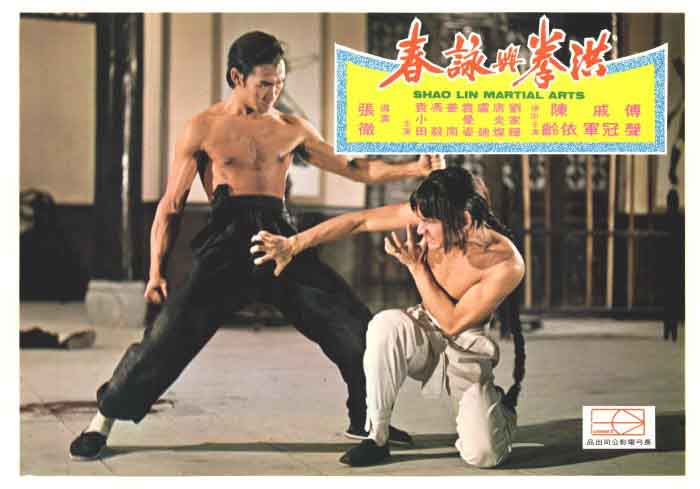Shaolin Martial Arts (1974)
Chinese Title: 洪拳與詠春
Translation: Hung
Gar and Wing Chun
Starring: Alexander Fu Sheng, Chi Kuan-Chun, Gordon Liu, Bruce Tong, Leung
Kar-Yan, Wang Lung-Wei, Fung Hak-On, Kong Do
Director: Chang Cheh
Action
Directors: Lau
Kar-Leung, Tong Gaai
According to Cinema of Vengeance, Lau Kar-Leung had sat down with Chang Cheh one evening to discuss what they could do to improve their movies (at this time, Lau was Chang’s most frequent action director). Lau Kar-Leung told him that they could start making movies that featured or were about Southern Chinese kung fu styles. According to Lau, the firstfruits of this conversation was Five Shaolin Masters, which kicked off Chang Cheh’s “Shaolin Cycle*,” which lasted until 1976**. Shaolin Martial Arts was one of the earlier entries in this period of Chang’s filmography, and while the themes show more of Lau Kar-Leung’s influence (indeed, in some ways, Executioners of Shaolin is a remake of this), the bloody graphic violence which frequently rears its head is certainly Chang’s.
Some 30 or 40 years after the burning of the Shaolin Temple and all the rigmarole that occurred with Chinese folk heroes Fong Sai-Yuk and Hung Hsi-Kwan, Shaolin martial arts is still being taught, without so much Manchu intervention. Or so it appears. In one unnamed town, there are two major schools, the Manchu School and the Lin School. The latter specializes in Hung Gar, the style founded by the aforementioned Hung His-Kwan. After a fight breaks out at what should be a peaceful religious celebration, the local Qing general decides that the teacher of the Manchu school (Kong Do), isn’t good enough at kung fu to run the place. So he brings in a new instructor, a mantis fist boxer (Fung Hak-On) and a pair of nigh-invincible fighters (Leung Kar-Yan and Wang Lung-Wei) to pick a fight with the Lin school. After the dust settles, several Lin students are killed and the rest flee.
The Lin Master sends two of his students (Gordon Liu and Bruce Tong) to learn the Eagle and Rolling Eagle styles in hopes of getting past Beardy’s “Iron Vest” technique and Wang Lung-Wei’s Qigong, both of which render the practitioner practically invulnerable. This doesn’t work, so he sends two of his other students (Alexander Fu Sheng and Chi Kuan-Chun) to learn the Tiger and Crane fist and Wing Cun, respectively. Cue more training sequences and fight scenes.
In many ways, this film feels like a dry run for not only Executioners of Shaolin, but Chang Cheh’s later Invincible Shaolin as well. Out of the three, I think I prefer Invincible Shaolin more, as the story is more focused and the fact that the Northern Shaolin fighters aren’t actually bad guys makes the conflict more compelling, since it brings of sense of dread to the inevitable final showdown. The major problem of Shaolin Martial Arts is that the second act focuses almost exclusively on Gordon Liu and Bruce Tong’s training, so when they exit stage right at the end of the second act, it feels like a huge waste of time in a film that was already running a bit too long. Starting the third act with two other characters beginning their training kills a lot of the forward momentum and the final fight ends up feeling rushed and anticlimactic.
There’s a greater focus on martial arts philosophies than brotherhood in this movie, which is why it feels more like a Lau Kar-Leung film than a Chang Cheh movie. On one hand, there are a number of different styles on display, which is pretty cool. I especially like how Leung Kar-Yan and Wang Lung-Wei both use different techniques (which one character makes sure to explain the differences between each of them), even if the effect is ultimately the same. I found it interesting that the Lin Master states how Qigong and Iron Vest have their individual weaknesses, which inspire his first students to train in the Eagle Claw style. But when he discovers that the two have both reached a supreme level of said styles, he instructs his students to learn other styles. It almost makes the Lin Master look careless and the deaths of the other students to be unnecessary. I also find it odd that the characters state that the Lin School teaches Hung Kuen (the Hung Fist, or Hung Gar), and then the master sends Alexander Fu Sheng’s character to learn the Tiger and Crane Fist with Simon Yuen Siu-Ting. Uh…isn’t hung gar BEST KNOWN FOR ITS TIGER AND CRANE PAIRED TECHNIQUE? Or was the Lin Master just focusing on other techniques, like the Iron Wire Fist and the Five Animals Fist?
The action is solid, if nothing special. Lau Kar-Leung and Tong Gaai (I’m going to guess he did more of the Eagle Claw fighting, since I believe more his training was in Northern styles) are still getting the hang of shapes-based combat. The biggest mistake in the action is the inclusion of Wing Chun and the decision to have Chi Kuan-Chun be the character to use it. In this film, the Wing Chun style is nothing more than the one-inch punch, which is both inaccurate and pretty silly when you think about it. I don’t think either Tong Gaai or Lau Kar-Leung knew enough about it to have Chi fake it, and they would’ve been better off casting either Ti Lung, or using a different style, like Mok Gar or Li Gar.
When it comes to Chang Cheh’s earliest “Shaolin Cycle” movies, I prefer Five Shaolin Masters, which had more and more varied action from everybody involved. I’m not sure I’d say this is for completists, because it’s not bad on its own merits, but Chang and Lau really did the same thing better in other movies.





No comments:
Post a Comment